You’re missing out on a powerful channel if you’re not using text messages to engage your customers. According to a study conducted by SimpleTexting, 80.5% of consumers check their SMS notifications within 5 minutes of receiving an SMS.
As a marketer, your greatest joy is to see your audience engage with your marketing content. With its incredible open rate, SMS marketing offers a direct path to achieving this.
However, successful SMS marketing goes beyond just sending text messages to your subscribers. You’ll need a strategic approach that respects your audience’s preferences. A strategy that delivers personalized content and offers platform-specific deals.
This article will discuss how SMS marketing best practices can help you achieve exceptional results.
1. Obtain written permission for texts
“What are the rules for SMS marketing?”
This is a question most marketers often contemplate when venturing into SMS marketing. The golden rule is to get explicit consent from your customers before sending text messages.
What exactly is consent, and what kind of content can you send based on the different kinds of user consent?
Let’s find out below.
Nonverbal consent
When a customer initiates contact, it’s safe to assume you have the customer’s consent to respond to their message. However, the consent to text them ends after you provide them with the necessary information.
You’ll need their consent again if you want to provide them with any other kind of information in the future.
Clearly stated consent
Businesses occasionally deliver informational messages, such as order status messages and appointment reminders.
However, you’ll need your customers’ permission before sending them promotional messages. You can get consent from your customers through a signup form on your site.
Alternatively, you can ask the customers for permission to send them promotional messages after they text you.
Written SMS consent
Promotional messages aim to promote and advertise products or services to potential customers. However, you can’t send these messages without their express written consent.
You can get explicit permission to send promotional messages by incorporating a checkbox into your online signup form. The form must also clearly state how they’ll receive your promotional messages.
When a customer fills out the form, you’ll have a documented form of their written consent for future reference. Maintaining a comprehensive record of all the permissions you’ve received from customers is advisable for future reference.
See the image below for an example of using a form to ask for customers’ express written consent.
2. Maintain regular SMS frequency
Strategic timing of messages is another SMS marketing best practice worth paying attention to. After getting permission from subscribers, it’s important to send your messages at the right moment for effective results.
Text messages are intimate, so don’t overwhelm your subscribers. Avoid spamming them with promotional messages.
It’s advisable to maintain a schedule. Maintaining a reasonable sending frequency allows you to provide valuable offers to subscribers without invading their personal space.
What is a suitable sending frequency? According to statistical data, the optimal frequency for SMS campaigns is one text message every other week.
Most customers (52.60%) prefer businesses to text them once a week, according to the same SimpleTexting survey cited earlier.
While this may differ from your desired frequency, respect your customers’ preferences and limit your messages to one every other week. Subsequently, you can increase the frequency depending on your subscribers’ interests and preferences.
Research shows that Tuesday and Saturday are the best days for sending text messages. Saturday has the highest conversion rate of 2.17%, followed closely by Tuesday with a conversion rate of 2%.
Unsurprisingly, Monday is the worst day of the week to send texts, with a conversion rate of 1.53%.

Image via Omnisend
3. Combine SMS with email campaign
While SMS marketing is a powerful strategy, using it as a standalone marketing tactic is not advisable. Combining SMS with email marketing creates a unified experience that increases brand loyalty.
An omnichannel marketing strategy gives you extra touchpoints with customers. It increases your brand recognition and makes driving customers down the funnel easier.
Unfortunately, many marketers still don’t combine these channels because they use tools that only support one strategy. Using an omnichannel marketing platform that integrates SMS and email campaigns saves time and effort.
A recent Omnisend study discovered that marketers who incorporate multi-channel campaigns generate a 494% higher order rate than those using only one channel.
Single-channel campaigns generate an order rate of 0.14%, while omnichannel campaigns have an order rate of 0.84%, an increase of 494%.
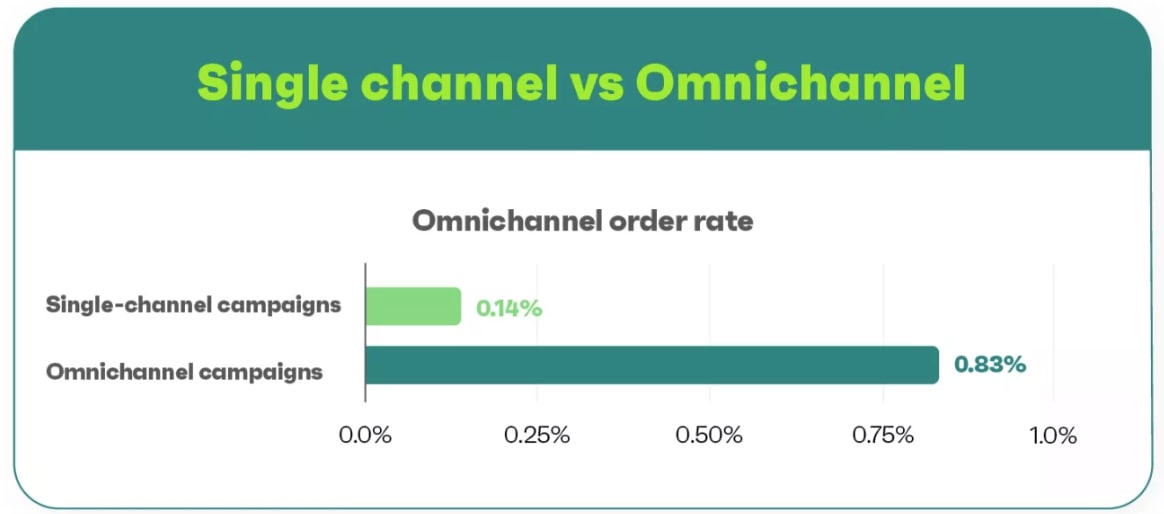
Image via Omnisend
This demonstrates that an integrated approach is how to increase your sales. Some of the top tools you can use for omnichannel marketing campaigns include Klaviyo, Sendlane, GetResponse, and Omnisend.
In addition to giving you extra touchpoints with customers, the other benefits of combining SMS and email marketing are:
- SMS campaigns for email non-openers: An omnichannel approach that includes SMS is a great way to get your message across for businesses that primarily use email. SMS has a higher open rate, and you can resend the offer via SMS only to customers who missed your email to make sure the message gets to the recipient.
- Enhanced cart recovery rates: Most businesses use email for abandoned cart campaigns. However, abandoned cart emails have a lower open rate. Adding SMS to the mix lets you use its high open rate to drive shoppers back to your store.
- You can use email for detailed campaigns: It’s advisable to keep your messages short and not include rich media like videos and GIFs. However, you can add them to deliver more information when sending an email.
- More effective targeting. Data from your omnichannel campaigns will help you understand how your users want to engage with each platform. For example, you may find that the CTR for your emails is highest in the morning while SMS’s peak is at noon. With this information, you’ll optimize the send times of each channel to reach your audience more effectively.
4. Use appropriate language
The character limit in text messages may force you to use shorthand. However, this shouldn’t be at the expense of professionalism, as is shown in the image below.

Image via Lolo’s thoughts
Using abbreviations rather than full words may give you additional writing space. However, there’s a likelihood that your readers will misinterpret your message.
That’s why using appropriate language is a crucial SMS marketing best practice.
When drafting your text messages, always spell your words fully to guarantee the recipients interpret your message correctly. When you need to shorten the text, use fragments rather than shorthand SMS lingo.
For instance, rather than saying, “This offer is valid till 10/10,” you can say, “Offer valid till 10/10.” By removing the words “this” and “is,” you reduce your character count without sacrificing message clarity.
This guarantees your audience understands your message while maximizing the limited character space.
The example below shows a text message that uses this SMS marketing best practice. After sharing the offer, the message says, “Valid till midnight” rather than “This offer is valid till midnight.”

Image via Omnisend
This concise approach optimizes the limited character space while ensuring the message stays professional and clear.
5. Mention your business in texts
Out of all the SMS marketing practices listed in this post, this is the most crucial one to adhere to. If you don’t mention your business in a text, don’t even send it.
According to Truecaller, the average individual received 19.5 spam messages in a month in 2022, up from 16.9 spam texts in 2021.
With cases of spam on the rise, you want to make it clear to your subscribers that your messages are legitimate. By clearly introducing yourself in the messages, you let your recipients know they interact with your business.
Doing so increases your chances of people opening your SMS and reading its content.
Don’t assume they have saved your contact even when you have texted the subscriber before. Always introduce yourself before getting into the message’s content.
The example below shows how best to introduce your business to subscribers via text. SF Sunglasses mentions the brand’s name at the beginning before delivering the message.
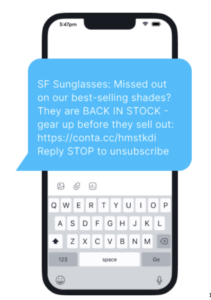
Image via Constant Contact
This small courtesy prevents confusion and makes recipients comfortable engaging with your texts.
6. Personalize SMS
To succeed as a marketer, sending personalized messages to your audience is important. Sending generic messages is the easiest way to lose favor with your customers.
Customers want brands to deliver customized experiences and are willing to share personal details to make this possible.
Including personal customer information can personalize your business texts. Include personal information such as:
- Customer’s name
- Location
- Gender
- Birthday
In the example below, Basic Piece addresses the customer by name in their business text.
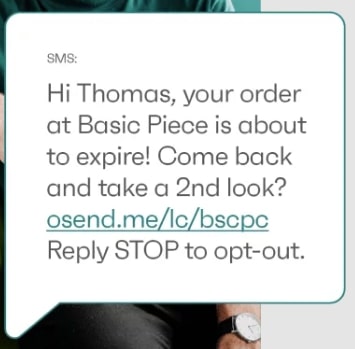
Image via BasicPiece
Personalizing your SMSs like this offers many benefits, such as:
- Building trust with customers
- Showing you care about customers and their needs
- Enabling you to capture the users’ attention
- Allowing you to deliver a positive customer experience
However, personalization goes beyond adding a customer’s name to an SMS. It also involves understanding and using your customers’ interests to deliver personalized content.
For ecommerce brands, you can track browsing and purchase history to recommend
7. Time SMS campaigns wisely
What is the best time to send your promotional text messages? As you implement these SMS marketing best practices, delivering your text blasts at the right time guarantees the best marketing performance.
According to Omnisend research, 10 AM, 1 PM, and 8 PM are the top three times to send text messages.
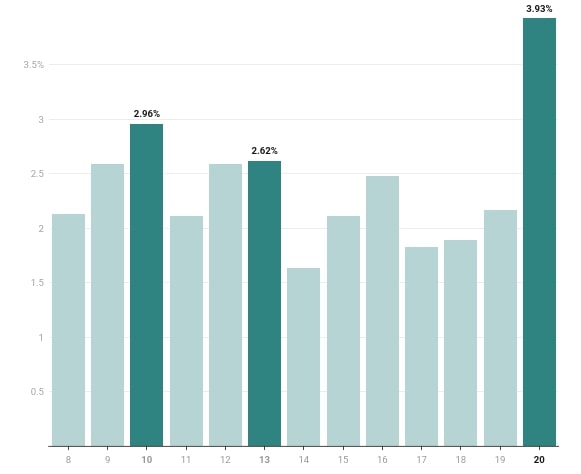
Image via Omnisend
The reasons these are the best times to send text messages are as follows:
- 10 AM: Most people are awake at this time and are active on their phones.
- 1 PM: Most people are on their lunch break and have time to check their phones.
- 8 PM: People are active on their phones while relaxing after work.
We’ve already established that Tuesday and Saturday are the best days to send text blasts. Therefore, delivering your SMSs at the times stated above increases the likelihood of your audience seeing, reading, and acting on your messages.
While you can use these research-backed times and succeed, you can also tap into your campaign analytics to find ideal times to send your messages.
Identify your most successful campaigns and review the times you sent those text blasts. That will give you an idea of the best possible times to send your marketing messages.
8. Be creative in SMS
You need to get creative with your SMS campaigns to increase your engagement rate. Customers receive a lot of texts, so the best practice for SMS marketing is to send creative messages.
One way to achieve this is by varying the content of your texts. Don’t send promotional messages all the time. Keep things interesting by changing your offers and content.
When you promote your products this week, send a fun piece of content next week. Subsequently, send a helpful tip before resuming your promotions. This dynamic approach will excite your audience to receive your messages and boost engagement.
Also, consider adding visuals to your texts, and from time to time send MMS messages.
The example below shows a text message incorporating a photo to spur engagement.
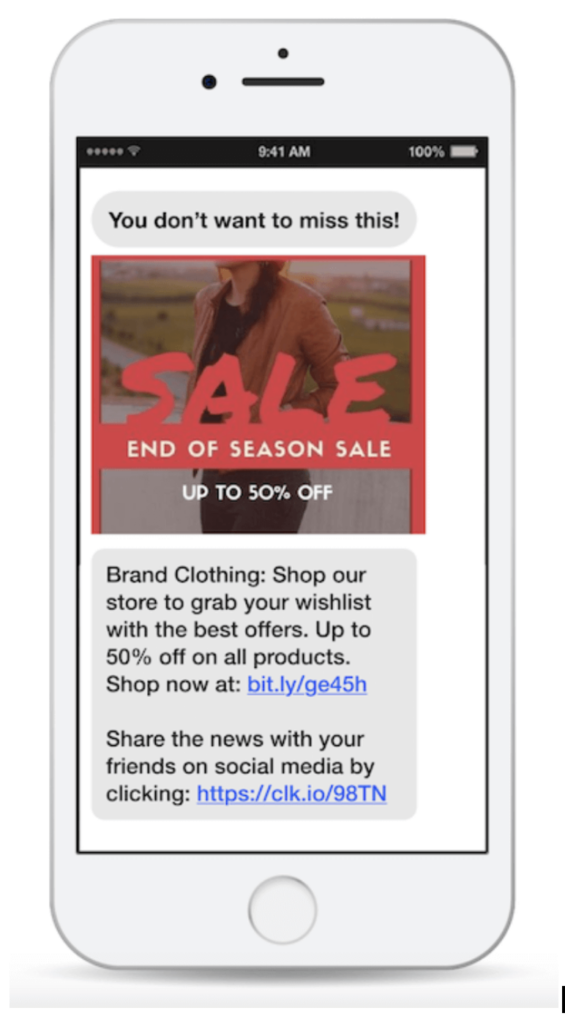
Image via CallHub
9. Offer exclusive text deals
As a marketer, you have multiple channels to engage your audience. But to grow your SMS channel, there should be an element of exclusivity.
Don’t use your SMS channel to recycle the offers you’ve already delivered through your other channels. Why would people sign up for your SMS campaigns when you recycle old content?
Remember, SMS is the most direct and personal customer engagement channel. As such, the offers you deliver through this channel shouldn’t be available on your other marketing channels. See the example below.
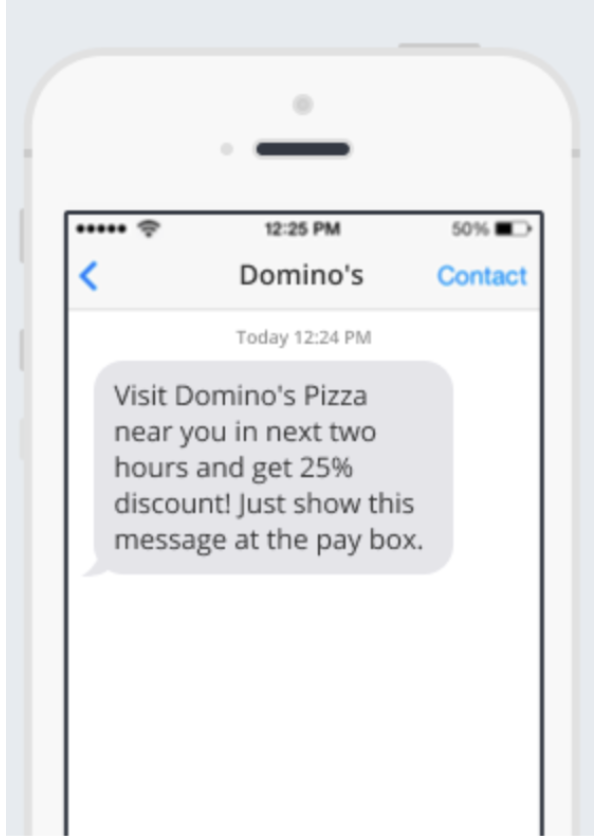
Image via Domino’s Pizza
If that’s difficult for you to accomplish, you can run marketing campaigns first via SMS before populating them on other platforms. This will give users additional reasons to subscribe to your business text messages, as they’ll receive timely information about promotions via SMS.
10. Grow your SMS list
Lastly, promote your SMS list to get as many people as possible to sign up. There’s the likelihood that the people you want to join your SMS list are already in your email list or follow you on social media.
Make the process as smooth as possible to encourage signups.
Offer incentives
Providing incentives is the fastest way to encourage customers to join your SMS list. Offer discounts, exclusive deals, or free items in exchange for signing up. This motivates customers to opt-in and gives them immediate value.
Promote on multiple channels
Include signup invitations on your website, social media platforms, email newsletters, and even offline marketing materials. The more touchpoints you use, the faster you reach your goal.
Make opt-in process easy
Simplify the opt-in process to avoid any potential barriers for customers. Use clear and concise calls to action, and minimize the number of steps required to sign up. Make sure the process is mobile-friendly since most users will sign up via their phones. A seamless opt-in experience will encourage more customers to subscribe.
Point of sale sign-ups
Integrate SMS list signups into your point-of-sale system. Train your staff to ask customers if they would like to join the SMS list at checkout, and provide an easy way for them to opt-in right there, whether it’s through a simple form or a text message. This method captures customers when they are already engaged with your brand and can significantly boost your SMS list.
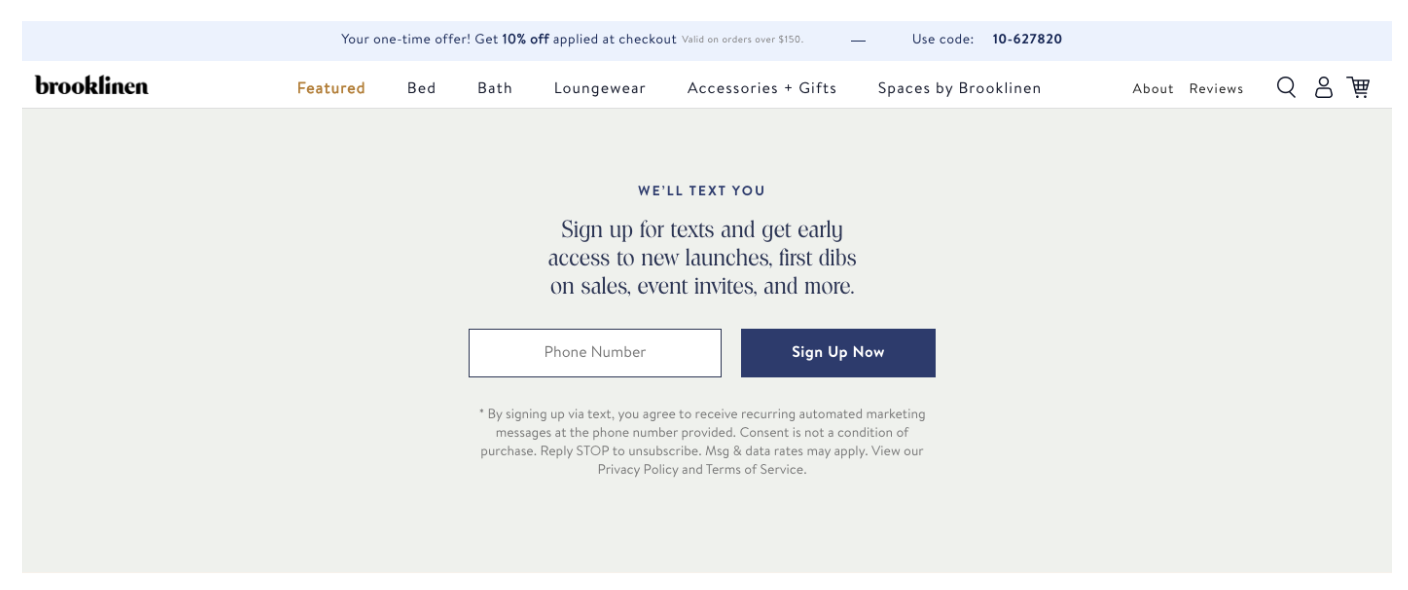
Image via Brooklinen
Additionally, use your email and social media profiles to promote your SMS list. To attract more subscribers, provide a compelling value proposition, like access to exclusive content.
SMS marketing best practices: Wrap up
With its high view and open rates, SMS is one of the most reliable channels to engage your audience. To use text messages to grow your business, follow the SMS marketing best practices shared in this article.
Start by obtaining consent to send text messages and maintaining a regular sending frequency. Ensure to use appropriate language and always mention your business in the SMS.
Additionally, personalize your messages for individual subscribers and give exclusive offers to encourage signups. Lastly, combine SMS with other channels, like email, to make your marketing more effective.
